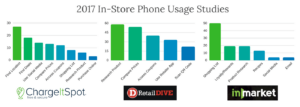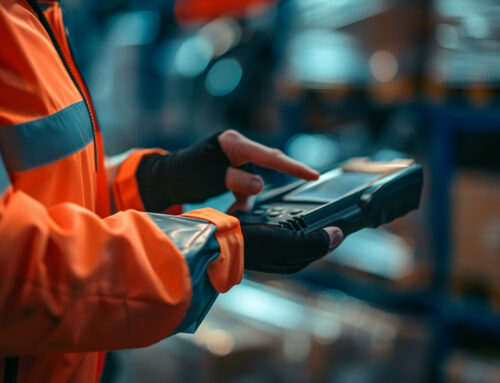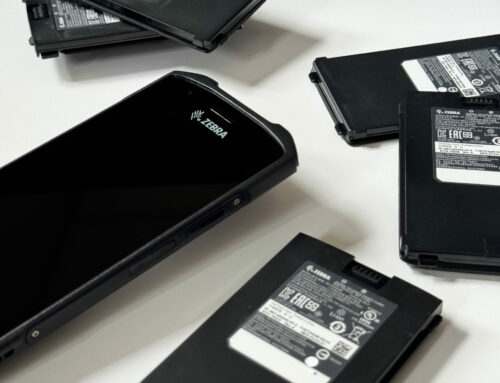In-Store Phone Usage: Current Stats and 2018 Predictions

It’s no secret that consumers use their phones everywhere – retail stores included. But exactly how are they using their phone while they shop is where it gets interesting.
How Shoppers Use Their Phones In Stores: 3 Studies
In 2017, several major studies were conducted about in-store phone usage trends.
Media company Retail Dive explored specific ways 603 shoppers used their phones while shopping in retail stores.
Beacon platform company InMarket surveyed 2,500 supermarket shoppers about their in-aisle phone usage.
At ChargeItSpot, our phone charging stations are equipped with polling capabilities which we regularly use to gather insight from users. This December 2017, we surveyed over 500 consumers at malls across the US about their main in-store phone activity during the holiday season.
Here are the results from these 3 in-store phone usage surveys, side by side:

Key Findings:
Retail Dive reported that researching a product and comparing product prices were the two biggest phone activities performed by shoppers in brick-and-mortar stores, in particular by those under age 35.
InMarket also reported that 19% of grocery store shoppers used their phones for product research. Their main phone activity, however, was consulting or making their shopping lists.
Our own study asked shoppers to pick the single most important activity they perform on their phone while they’re in a brick-and-mortar store. Surprisingly, the overwhelming majority responded that they simply used their phone to search for a store location! The second most important activity? Looking up a deal on an item.
What Retailers Can Do To Optimize In-Store Phone Usage By Customers
While showrooming and phone usage was once dreaded by retailers, they’re now beginning to see how they can harness the consumer’s growing phone obsession to increase sales.
Here are some key takeaways from the data revealed in these three studies:
- With 27% of shoppers using their phone to find a store location, retailers must make their address (and, by extension, their store hours and contact number) easily findable online. That means, properly filling out your Google My Business profile and keeping it up to date. It also means ensuring that your website features a location page with all the necessary info a consumer could need – all visible on a single page.
- Scoring a deal is still an essential part of a positive shopping experience. Integrate promotions in your store app, update your social media profiles with the latest deals, and create a “current promo codes” page on your website so shoppers can find the newest codes. Another pain point for consumers is when a brick-and-mortar store charges a different price for an item than their own website. If syncing store and web prices is difficult, then be sure that you’ve implemented a price-match guarantee so shoppers who get to the cashier’s desk can simply ask for a web price match and receive it.
- Shopping lists are clearly an important organizational tool for savvy consumers (according to InMarket, half of all grocery shoppers are consulting theirs on their phone!) so why not offer a shopping list tool within your store’s mobile app? Not only would it help consumers keep track of items they need to pick up from the store, it would also give retailers an added opportunity to communicate promotions, specials and new products to the consumer.
- Product research is one of the most widely performed phone activity in retail stores, therefore retailers need to take a good look at their product pages. Do your product pages contain all the necessary information a consumer would be looking up, such as dimensions, size guides, materials, technical specs, and, most importantly, consumer reviews? Sometimes, a single 5 star review for a product is all it takes for a consumer to take the product to the checkout line. Make sure you’re not missing out on an opportunity to convert a store browser into a buyer by activating a review option on your product pages.
What to Expect for 2018
In order to thrive in 2018, retailers must give busy consumers an incentive to take the time to go to a physical storefront to make a purchase. Whether it’s a fun store environment, a top notch sales team that gives killer recommendations, a gift with purchase or a price match guarantee, shoppers are looking for that “extra something” that gets them off the couch and into stores.
And the shoppers who do make it to the store are turning to their phones to give them a reason to purchase (or not purchase) a product. At the very least, don’t give them a reason not to make the purchase. Read our recent blog on Simple Ways to Improve the In-Store Shopping Experience for some data-backed recommendations like hiring a friendly and knowledgeable sales team and making the check-out process quick and seamless.
The big takeaway is this: every single step of the consumer’s path to purchase should be re-evaluated for the 2018 consumer. Is your sales team the best you can afford? Are your prices competitive or do you offer a service or rare product that justifies your higher pricing? Are you taking advantage of retail technology tools like beacons, heatmaps and data-collecting phone charging stations like ChargeItSpot to send relevant information, promotions and specials to customers as they travel through the store? Is your return policy generous? Have you made mobile a priority? More than half of retailers considered mobile initiatives among their top three priorities in 2017 (according to a recent report from the National Retail Federation’s Shop.org division and research firm Forrester). That number will likely be even higher for 2018. Don’t be left out of the game by underestimating mobile’s essential communication and engagement opportunities.
Retailers have been faced with the harsh new realities of e-commerce and the mobile revolution for almost two decades now. Make 2018 the year you pull your head out of the sand and leverage these new consumption habits – and the technologies that feed them – to your advantage.








